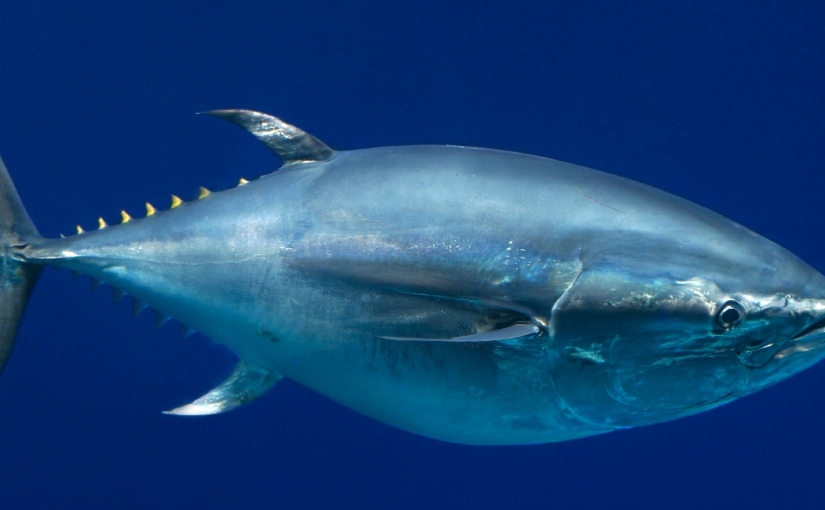From Jan. 18-20, Monterey Bay Aquarium and Stanford University will convene the world’s leading bluefin tuna researchers, policymakers and stakeholders for the Bluefin Futures Symposium in Monterey. Using the power of its global expertise and diverse perspectives, the group will explore opportunities for international collaboration. Together, the participants will work to create a roadmap toward healthy and sustainable wild bluefin populations across the world’s ocean.
Here, the Aquarium and three symposium sponsors share their thoughts and hopes for Bluefin Futures.
Margaret Spring
Vice President of Conservation & Science and Chief Conservation Officer, Monterey Bay Aquarium
For decades, scientists around the world have been on a quest to understand bluefin tunas, some of the ocean’s most fascinating, powerful and mysterious top predators. Through our 20 years of collaboration at the Tuna Research and Conservation Center, Monterey Bay Aquarium and Stanford University have made significant scientific contributions to our understanding of these amazing animals.

But given increasing global threats, a future with abundant bluefin tunas will require internationally coordinated research, conservation and management. In a global first, the Bluefin Futures Symposium will bring together many of the world’s leading experts on all three bluefin tuna species in advance of international scientific and management meetings. During the symposium, we’ll be sharing the latest research, science-based management approaches and opportunities to define a sustainable path forward for these iconic and ecologically important species.
Monterey Bay Aquarium is honored to co-host this gathering of world experts, and we’re grateful to our many sponsors. I look forward to hearing from our distinguished speakers and participants on how, working together, we can achieve conservation success for bluefin tunas.
Campbell Davies
Senior Principal Research Scientist, Marine and Atmospheric Research, Commonwealth Scientific and Industrial Research Organisation
Bluefin tuna are iconic species which have captured the imagination of people around the globe for millennia. CSIRO has a long history of association with southern bluefin tuna. Our multi-disciplinary research program, over many decades, has made substantial contributions to our knowledge of the species, methods for studying them (such as archival tagging technology), and development of the early cooperative science and management arrangements required to manage the international fishery.

We are very pleased to support the Bluefin Futures Symposium. The meeting provides the first opportunity for the global bluefin tuna community to come together and share their understanding of the current state and potential futures for these spectacular fish and the diverse range of fisheries they support.
I’m looking forward to an insightful and productive meeting. I hope it will stimulate the next phase of international cooperation required to conserve the world’s bluefin populations and the fisheries, societies and cultural traditions that depend on them.
Amanda Nickson
Director of Global Tuna Conservation, The Pew Charitable Trusts
This important symposium is a global call to action. We must work together to identify conservation solutions for bluefin tuna that are grounded in good science. With such a large representation of viewpoints and expertise from the world’s foremost bluefin scientists, managers and stakeholders, there is an opportunity to complete a roadmap for ending overfishing of all bluefin populations, rebuilding them, and putting safeguards in place to ensure bluefin are never overfished again.

High human demand coupled with insufficient management has put at risk all bluefin tuna species at some point during the last 50 years. There are still populations that have been fished to the brink. The Pacific bluefin tuna catch has been so high that just 4 percent of the population remains today. Current management measures won’t do enough to reverse the decline.
All bluefin species should be valued and managed as much for their ecological importance as they are for the price they command at market. It’s especially critical to cooperate and collaborate to save Pacific bluefin.
Russell F. Smith III
Deputy Assistant Secretary for International Fisheries, National Oceanic and Atmospheric Administration
The Bluefin Futures Symposium provides a unique opportunity for us, as scientists and managers, to consider how best to manage bluefin tuna stocks in order to ensure their long-term sustainability.

Working through the regional fishery management organizations, we should develop harvest strategies that take full advantage of innovations – for example, through use of management strategy evaluation – that help us respond to what we know about changes in the stocks and the fisheries.
At the same time, we should apply a precautionary approach to take uncertainties into account. We must also adopt objectives that lead to meaningful progress in rebuilding depleted stocks. Like the joint tuna regional fisheries management organization process (also known as the Kobe process), this symposium allows us to compare experiences in different oceans and consider how lessons learned might apply elsewhere.
